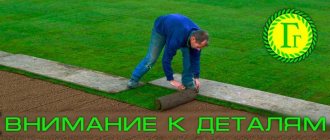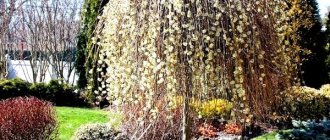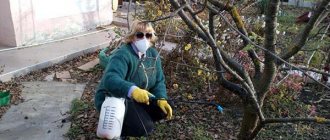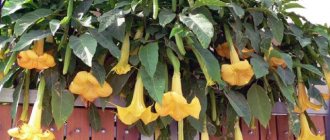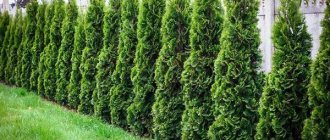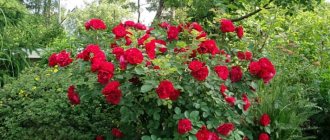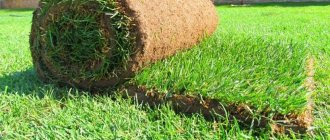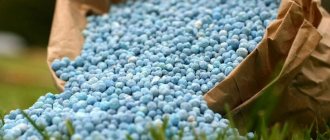Perhaps every gardener dreams of a real English lawn. I can't think of a better place to relax, a barbecue area. A green carpet becomes beautiful and dense after regular maintenance. Some of the work is carried out in the autumn season, we will talk about them. I propose to move straight from theory to practice; I will share my own experience and observations of neighbors.
Source: yandex.com
Should I mow the lawn before winter and when should I do it?
There is no point in shaving the grass bald; a cover of 6 to 8 cm in height disappears under the snow. Preparing the lawn for winter is carried out with the beginning of leaf fall. Sometimes the first leaves begin to fly at the end of August, but this is not a signal for autumn pruning.
When the trees begin to shed their leaves en masse, it’s time. The garden and vegetable beds are empty at this time, the main harvest has already been harvested.
It is imperative to mow the lawn before winter. Grass that is too tall will interfere with spring growth. The last time in the fall is to cut before frost, until the grass has withered and is well cut.
A green carpet can be seriously damaged if the grass is cut too late. The roots need protection until the snow cover is established.
Fertilizing the lawn in the fall: when and what to fertilize with
Fertilizers containing nitrogen should not be added to the soil.
Urea and ammophoska are needed by the plant in the spring, at the beginning of growth. When going to sleep, grass needs minerals.
Autumn fertilizers include:
- Superphosphate is a source of phosphorus. Up to 40 mg (2 matchboxes) are applied per m2, depending on soil fertility. If superphosphate is double, the rate is halved.
- Potassium-containing preparations are wood ash (up to a glass per m2), potassium nitrate, potassium sulfate or potassium chloride (norm 20 g per m2/matchbox).
Calcium is found in slaked lime, chalk, and dolomite flour.
All these components are deoxidizers and reduce soil acidity.
https://www.youtube.com/watch?v=LtWEbOu0NIQ
The norm is a glass per m2, if the soil is acidic, the norm can be increased by 1.5–2 times.
Complex fertilizing is applied to dry grass before watering. Minerals stimulate root growth and the formation of new growth points. Fertilize lawns a month before severe frosts, no later.
Lawn scarification in autumn
When cutting grass, it is difficult to remove all the cut blades. When the lawnmower is equipped with a storage unit, the main green mass is collected. When working with a trimmer, everything scatters around the area. It will not be possible to thoroughly rake the cuttings. Over time, a fleecy covering resembling felt forms near the ground.
Scarification is a procedure for removing thatch from the lawn, which prevents the growth buds from developing. When the green carpet is clogged, the earth does not breathe; over time, the grass becomes thinner and becomes brittle. Removal of fine thatch is carried out to strengthen lawns, and new apical layers appear.
Some varieties of grass are creeping, for which scarification is especially important.
The completely thatched layer should not be cleaned; for natural protection, a cover of 5 mm is considered normal. The straw felt is raked with a fan rake. Ordinary ones with sharp teeth should not be used, they will stick into the grass and tear out bushes. Wealthy gardeners use a verticutter - a special device with vertical knives.

Fan rake, Verticutter
This tool runs on mains power or on a mixture of gasoline and motor oil. The mechanism cuts the felt surface while rotating at a certain frequency. After such treatment, lawns are usually renovated - seeded, mulched with a thin layer of humus, and watered well.
Cleaning the lawn
Regardless of when the lawn is mowed before winter, it is important to remove clippings and other plant (and other) debris from the soil. Before harvesting, it is advisable to clear the soil of moss. This procedure is called scarification (cutting) or verticutation (combing out). The essence of the work is to remove turf felt - dying and withering grass. When the vegetation on the lawn “falls asleep” in the autumn, the number of dead and yellowed blades of grass increases, making the lawn sloppy and dull. Removing the turf felt restores the lawn's rich green color and - more importantly - makes it easier for air to reach plant roots. The video offers a more detailed understanding of the essence and sequence of work performed.
Read also: Essential cedar oil beneficial properties and contraindications
The illustration shows the appearance of the lawn before and after combing.
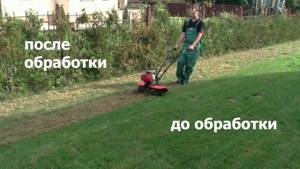
The turf felt brought to the surface is raked and removed along with the moss, “cut out” and “combed” along with the withering grass.

If the appearance of the lawn is not important, you can use already mown grass for mulching. However, for this purpose, already dried raw materials are used; you should not leave the grass on the lawn immediately after mowing.
Lawn aeration in autumn
I'll start by explaining what aeration is and why it is needed. Aeration is essentially a deep loosening procedure. If you do not loosen the lawn using the usual method used in garden beds, the vegetation will die and bald spots will appear.
Lawns are pierced with a large fork or a special device - an aerator. Through holes in the turf and crumpled soil layer, oxygen reaches the roots. The grass breathes and grows better.
Aeration can be carried out at any time of the year. In autumn, the soil is aerated when the weather permits: dry and relatively warm. It’s better not to trample on a wet lawn again, it will do more harm than good.
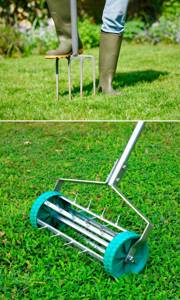
Pitchfork, Aerator
The forks are stuck into the turf in increments of up to 20 cm; there is no need to cut too much. The layer of turf is slightly lifted, tilted towards itself. It is good when the teeth enter to a depth of at least 20 cm. By the way, during periods of heavy rain, excess moisture drains well into the holes.
After autumn aeration there are no puddles on the green carpet.
Aerators are needed when large areas are allocated for the lawn. In small areas with a heavy roller studded with spikes, it is impossible to turn around. Pitchforks are much more convenient.
Aeration – creating comfort for the roots
To carry out aeration, it is enough to make punctures in the turf layer so that the air freely reaches the roots. Ventilating the underground part of plants feeds the roots with oxygen and prevents water and air from stagnating. Moderate circulation of air masses prevents the occurrence of fungal diseases and rot.

To combine the process of lawn aeration with a healthy walk in the fresh air, original devices worn on shoes - aerator sandals - will help
Lawn aeration is usually done in the fall or spring, but never in the summer, when too high temperatures can cause drought. Before cutting the turf, you should water the lawn thoroughly for two days in a row. The puncture depth is from 8 to 10 cm.

The most common aerators are powered by a gasoline engine or mains power. Average power – 1400-1600 W, working width – 30-40 cm
The traditional tool for aeration is an ordinary fork. If the lawn is small in area, then they will be quite enough. When an area covered with grass takes up a lot of space, a special device is required - an aerator. There are several types of aerators, differing in technical characteristics and purpose. For example, a series of aerators serves for parallel formation of the root system.

A distinction should be made between piercing and pinching during aeration. Piercing is a deeper process: suppose the pitchfork penetrates to a depth of 8-10 cm
Along with aeration, they perform verticulation - they cut off unnecessary shoots and excess stems with a special apparatus equipped with a knife mechanism. A good time for this event is the end of spring and the beginning of autumn. Immediately after verticulation, seasonally appropriate fertilizers are applied.
Recent Entries
5 working ways to use tar in the garden 7 indoor plants that help you get married even in adulthood Indoor plants that can bloom in trouble
Watering the lawn in autumn
Watering is considered an important element of lawn care. It is carried out using the sprinkling method.
Automatic watering is turned on when there has been no rain for several days; it is undesirable to allow the soil to dry out.
It is believed that in order to prepare for winter, the soil needs to be soaked to a depth of at least 30 cm, but this is not a universal norm. Much depends on the composition of the soil. In autumn, in loams, water stagnates and forms puddles, while in sandstones, on the contrary, it goes too quickly into the lower layers.
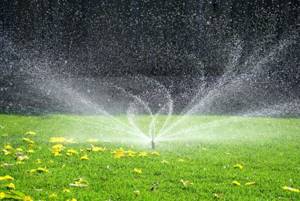
Source poliv2000.ru
Watering is stopped when frost is noticeable on the grass in the morning. Sometimes after a cold spell it becomes warm again and the sun makes us happy. But this is not a reason to start watering the lawn again. The condensation that falls at night when the temperature drops is enough for the grass. The plant is preparing for the dormant season, metabolic processes slow down.
If the lawn is not watered at all in the fall, in the spring it will be uneven - grass tussocks in some places where there are small depressions will definitely stick out.
They have to be trampled down in the spring, the level of the horizon leveled with soil, and the seeds replanted. This is a tedious task. So autumn watering is a mandatory procedure.
Last time to mow the lawn

In summer, the grass near the house is cut every 7-10 days, as it grows quickly and intensively. In autumn, the procedure is done less frequently. The last cutting is carried out in October before the first night frosts. The air temperature should remain 10-12*C. If you don’t cut the grass before winter, it will fall down with the first frost, begin to rot, and become an obstacle to the growth of new plants in the spring.

You may be interested in:
The first lawn mowing after planting: when to do it Caring for lawn grass is an integral measure for maintaining the garden area in order. To…Read more…
You may need to mow your lawn more than once before the cold weather starts. When the weather is warm in September and it rains periodically, the grass quickly grows back. If in October you don’t have time to trim before frost, then he may grab uncut greenery, it will fall down and begin to rot.
Each region has its own deadline for the last mowing of the lawn:
- north of the country - September 15-25;
- the central part of the Russian Federation - October 1-10;
- southern regions of Russia - October 15-25.
Important!
Mowing later in November will not allow the plants to recover before frost or the first snow; the grass may freeze.
Rolled lawn in autumn
When the grass roll lawn has grown in, it must be cared for as usual. In the fall it needs pruning and watering with fertilizers. While the root system is forming, it is worth checking the establishment of the lawn.
It is not worth laying new rolls in the fall, they will not take root. Traditionally, lawn sheets are laid in the spring.
Over the summer they have time to acclimatize and put down new roots. They try not to walk on a young lawn, but autumn is not that case.
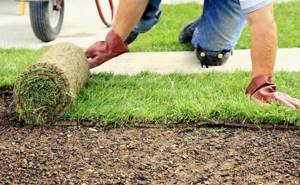
Source: rostov.pulscen.ru
The grass withers and turns yellow when the roots rot. If necessary, additional drainage is done - the plates are raised, the soil is dug up, vermiculite, sand, and dry peat are added to it.
It is better to replace damaged areas the next season. If the cover is uneven, after aeration and removal of felt, seeds are sown.
Planting before winter is effective for cereals, ryegrass, and bluegrass.
I know from experience that it is better to choose the same lawn seed mixture that was used to germinate the rolled lawn. This is especially true for bald spots. When seeds are broadcast to thicken the coating, one type of plant can be used.
It is recommended to cover a green artificial grass carpet (some people make such a covering in local areas) with a film or cloth so that it does not fade in the thawed areas under the rays of the spring sun.
Caring for specific types of lawns
In addition to the classic “English” lawn, formed by plants of the same species, so-called “meadow” or “blooming”, “Moorish”, “sports” “ground” versions of lawns are arranged. They differ in the set of plants and the height of the grass cover.
A meadow (flowering) lawn is closest to a natural meadow, so it is cut to a greater height (8...10 cm) and cut after perennial plants bloom and before another plant variety begins to bloom.

The Moorish lawn requires virtually no mowing, or it can be done manually so as not to damage perennial and flowering plants. Lawn care in the fall involves carefully removing debris and turf felt, fertilizing, watering and, if necessary, mulching.
Sports and parterre lawns are mowed shorter than regular lawns, so the last autumn mowing for them may occur later. Careful care of these types of lawns is required, especially for the capricious parterre option.
Mr. Summer resident recommends: two tips
- A few words about the fight against moss; it grows everywhere, especially loves semi-shaded areas. Sphagnum must be removed as soon as small pockets appear, otherwise the moss will quickly spread throughout the lawn. First of all, we water the lawn with Florovit and dilute it according to the instructions. There are packages marked “M”, where the concentration is higher. This is iron sulfate - iron sulfate, from which the moss darkens, then disappears from the area completely. With regular aeration, moss plants are formed less frequently.
- What to do with the leaves? From my own experience I was convinced that it is still better to collect the foliage. I do this myself after the first snow, early in the morning, while the soil is frozen. I sweep the leaves to the edge of the lawn and then collect them from the path into trash bags. It takes much less time to remove leaves in the fall than in the spring. The lawn thaws more evenly, and rotted dark spots often appear under layers of frozen foliage. When the leaves are single, the last ones, they are not so terrible for the green carpet.
